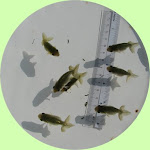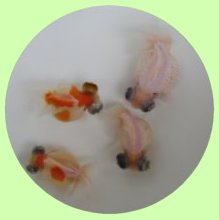Got Murphed Again? - 莫非墨菲?
 墨菲定律 ~指詼諧的經驗之談,其要點為:任何事情都不象看上去那么簡單;任何可能出錯的事將出錯。
墨菲定律 ~指詼諧的經驗之談,其要點為:任何事情都不象看上去那么簡單;任何可能出錯的事將出錯。 Sometimes, I can't help but marvel at the mischiefs of Mr. Murphy. The day I forgotten to shade one of the ponds, the sudden surge of temperature to more than 34 degrees celsius had caused most of my fries to change colour too early. I also got a "hand slip" scrubbing a pond and injured my neck and shoulders. Immobilized for a few days, some fishes got sick from overcrowding because I couldn't cull fast enough and change water. Two of the fishes I earmarked before were confirmed to flunk as show fishes - one with nice tail has a bent head while the other with nice head has a bent tail :( What luck! Anyway, these two fishes will be my seed fish candidates.
Sometimes, I can't help but marvel at the mischiefs of Mr. Murphy. The day I forgotten to shade one of the ponds, the sudden surge of temperature to more than 34 degrees celsius had caused most of my fries to change colour too early. I also got a "hand slip" scrubbing a pond and injured my neck and shoulders. Immobilized for a few days, some fishes got sick from overcrowding because I couldn't cull fast enough and change water. Two of the fishes I earmarked before were confirmed to flunk as show fishes - one with nice tail has a bent head while the other with nice head has a bent tail :( What luck! Anyway, these two fishes will be my seed fish candidates. Come next year, I will breed more so that Mr Murphy would not have time to sabotage all the fishes :)
Come next year, I will breed more so that Mr Murphy would not have time to sabotage all the fishes :)
Pictures:
1) Fries that change colour too fast due to the warm water.
2) BBR with a bent head alignment.
3) BBR with a bent and overlapped caudal tail.



























